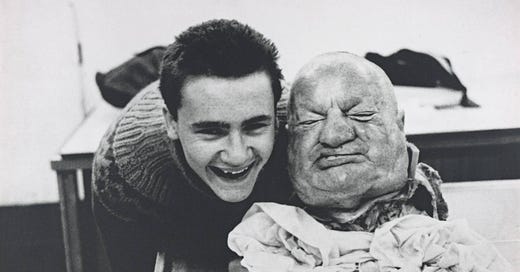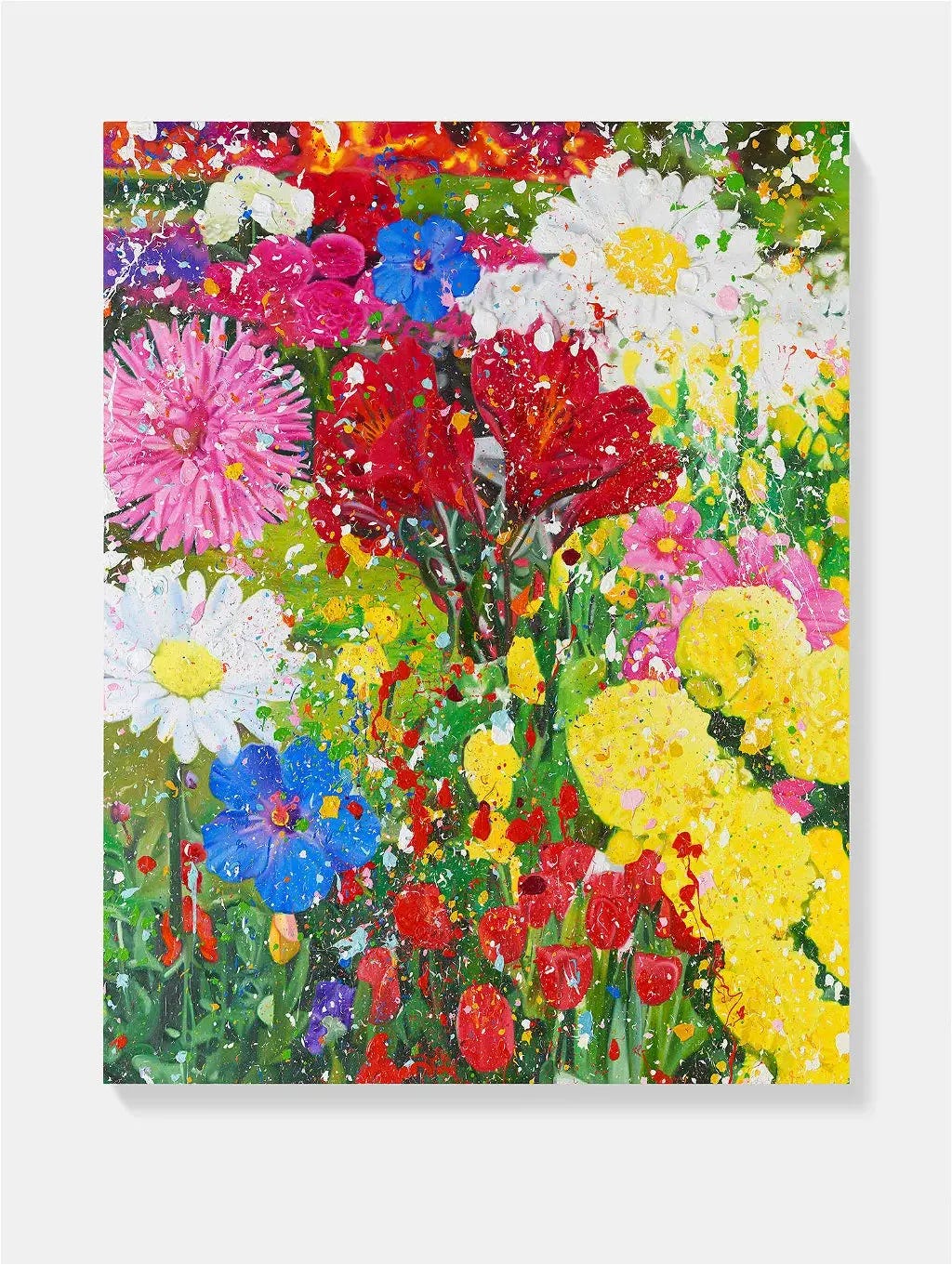Damien Hirst will not last
Are you joking? The ringmaster of Freeze has changed the market AGAIN
If you send me a postcard, I’m going to keep it. This week, while clearing a box of stuff, I found a postcard my mother sent me years ago. It had been provoked by a piece I had written about a show by Damien Hirst. “Beautifully written” says my mother (as all mothers do), “I really can’t see myself going,” she continues. “D.H. will not last, except as a gimmick. Much love, all the same. M.”
Well well. My mother died a few years ago, and stopped going to galleries about 10 years before that, so perhaps this card was written in 2012.
And it’s true, the artist has been a bit quiet of late, at least compared to the days when he was in his pomp. What fun that was! The Hirst era coincided with when I was in my own pomp as the BBC’s Arts Correspondent, and I can tell you that having Hirst in my sights and on the running order was a laugh.
Away From The Flock AFTER the Black Ink Episode.
I covered Hirst winning the Turner Prize in 1995, Hirst’s pickled woolly white lamb (Away from the Flock) being sabotaged by a pot of black ink, Hirst appearing on Top of the Pops. Who cared about whether an artist would ‘last’? He was the iconic showman who united publicly funded institutions and private money, and entertained everyone with pickled sharks and easily understood statements about Death, and Life.
The enfant terrible…With Dead Head (1991), taken by a friend at Leeds University
The present was all. This was Cool Britannia, Tate Modern was a building site and the group known as the YBAs, with Hirst as ringmaster, had at last managed to make contemporary art fun and engaging. The zeitgeist had personality and daring, and it was was over HERE, not over THERE, stuck up some academic ivory tower or embedded in a worthy circle of slates on a freezing cold mountain. Damien and his friends had changed the nature of art, and art consumption and furthermore they had changed the consumers.
The New York Times ponders the Hirst phenomenon
I was so excited by all of this that I wrote a book, The Tastemakers, about it. And about Hirst, who is nothing if not one, I said something profound along the lines of – keep an eye on him. You don’t know what he will do next.
A free copy to the first person who can tell me what the cover signifies! (and who it is by)
And thus it has come to pass. DH has not got a vast new show opening in Paris this spring, unlike the other DH, the blonde one from Bradford. He has not got a gong, unlike Dame Tracey. He is not (as far as I know) a Trustee of anything, or been invited to do the Reith Lectures. He is not on the guest list of the Great and the Good. There was even a scintilla of scandal attached to him last year when the Guardian ‘revealed’ that some of his famous pieces from the 1990s were actually made in 2017.
Does he care about this? Does he hell. The monetary success of What Damien Did Next (And It Has Nothing To Do With Sharks), is so colossal that I am leaving details until the end.
Just as Hirst disrupted the stodgy market for contemporary art with his legendary first production Freeze (1988), he has done it again. And forget pricey one-offs. This is all about going straight to the consumer, mostly with pre-ordered prints, which as artists (Durer, Goya, Picasso) have always known, are far more than fine art’s poor relation, since they offer the chance not only for accessibility, but also for scale. Via his partnership with tech company HENI, run by Joe Hage, Hirst has reinvented the way art is marketed. He is the first blue-chip artist to sell his work (in this case, editions of prints), via ‘drops’ – a technique of marketing invented by hip fashion or record labels and facilitated by social media, where people are told of the forthcoming arrival of a certain item, and invited to order it within a short window of time. The individual print is not off-the-scale expensive, but there are a LOT available. If you want.
It didn’t happen immediately. His first print release with HENI, H1 Enter the Infinite, was in 2016. Everything happened the regular way. A series of 180 prints was made (9 images each in an edition of 20), marketed and sold. The turnover was just over $1million. Close, but no cigar.
Enter a drop, four years later, for the H7 Rainbow Editions series. The prices were modest; large prints were sold for £1000 and smaller ones for just £300 (this was in the middle of the pandemic, and profits went to the NHS). But the strategy worked; the volume of orders was far higher than those for a traditional print edition. By 2022, a single dropped series, the tenth, was making more than $53 million for Hirst and HENI.
Through timed and marketed drops, Hirst has sidestepped galleries, auction houses and private views. Because he is producing to online orders, there is no waste. That the work turns up in the secondary market and is then handled by galleries and auction houses is simply an additional bonus. A complete set of H9-The Virtues sold at Phillips two years ago for just over £100k. Does he care about saturating the market? Doesn’t look like it, and the figures don’t show any sign of collapse. If you want to be in the know for the next drop, sign up here at the HENI site.
Of course, there are some people who (like my mother) resent the prophetic nature of Hirst. David Hockney might use an iPad but at least he does it politely, within the confines of the Royal Academy or the Fondation Louis Vuitton. Hirst doesn’t bother with this. He just goes straight onto the ‘gram.
From H14, The Secrets
Some people are very grumpy indeed. “I’m offended that Damien doesn’t even seem to be bothering to put any effort into ripping us off any more. Sad day for the art world,” writes one. “Over priced and mass produced…this is not what art is about.” Really? Even Dame Tracey RA has put the boot in. “Damien was a young artist that started off with a lot of that belief and a lot of that conviction,” she told Louis Theroux on his podcast. “He was like a force. And now he’s not.”
I think that is untrue. Maybe it’s just the force he has found is away from the hallowed halls of the Royal Academy, maybe somewhere closer to real life, with all its digital, A1-inspired, non-fungible terror. HENI, “a technology company pioneering art markets and information,” aims to “make art accessible to everyone by giving people the chance to learn about and collect art.” This last statement is remarkably close to the noble aspirations of the Arts Council of England, only with more panache and (quite possibly), a lot more digital expertise.
Now for the figures. How much has Hirst made?
According to MyArtBroker (whose excellent piece by Erin Atlanta-Argun I have extensively quoted from here), Hirst and HENI have, via 14 print ‘drops’, two works on paper releases and 3 NFT releases, turned over a total of $206,445,375.
Some gimmick!










The cover of your book is Martin Creed's lights going on and off that won the Turner Prize. That's my guess.
What a wonderful read, cheering the end of a long cold work Friday, thank you